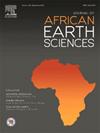Multi-disciplinary approach to evaluate hydrocarbon potential in the Bornu Basin, Northeastern Nigeria
IF 2.2
4区 地球科学
Q2 GEOSCIENCES, MULTIDISCIPLINARY
引用次数: 0
Abstract
The Bornu Basin, a sub-basin of the Chad Basin in northeastern Nigeria, has experienced extensive petroleum exploration activities, with 23 wells drilled; however, only two encountered sub-commercial gas volumes. This study integrates well log data, sequence and seismic stratigraphy, structural interpretation, and fault seal analysis to better understand reservoir extent, depositional environments, and hydrocarbon trapping mechanisms. Well log analysis reveals a stratigraphic sequence gently dipping from southwest to northeast. The lowermost Bima Formation (Albian), composed mostly of sandstone, reflects a fluvial to continental setting. The Gongila Formation consists of interbedded lithologies, thinning southwestward. The Fika Shale, marked by high gamma ray readings, serves as a thick, continuous seal. The Gombe Formation, with alternating sands and shales, indicates fluvial to shallow marine conditions. The sandy Kerri-Kerri Formation suggests a continental environment, while the Chad Formation comprises clays and shales with minor sandstones. Sequence stratigraphic analysis identified three third-order sequences. Reservoir evaluation in Bulte-1 and Kasade-1 wells identified three potential reservoir zones (Cha-Res-1, -2, -3) in the Kerri-Kerri, Gombe, and Gongila Formations; respectively. The Kerri-Kerri and Gombe Formations show better reservoir quality with good porosity (0.13–0.18) and net to gross (0.93–0.98); respectively, while the Gongila Formation is poorer due to higher shale content (0.150–0.157) and high-water saturation (0.99–1.00). Seismic data revealed complex faulting patterns like normal, listric, and reverse especially in deeper zones, along with possible igneous intrusions. Two anticlinal leads were identified. Fault seal analysis suggests moderate sealing capacity with a Shale Gouge Ratio of 0.22–0.35. Rose diagram, Fisher mean vector statistics and Bingham axial distribution analysis suggest that the faults are trending in Northeast-southwest direction.
多学科方法评价尼日利亚东北部Bornu盆地油气潜力
Bornu盆地是尼日利亚东北部乍得盆地的一个子盆地,经历了广泛的石油勘探活动,钻探了23口井;然而,只有两个地区的天然气储量低于商业水平。该研究综合了测井资料、层序和地震地层学、构造解释和断层密封分析,以更好地了解储层范围、沉积环境和油气圈闭机制。测井分析显示,地层层序由西南向东北缓慢倾斜。最下面的Bima组(Albian)主要由砂岩组成,反映了河流到大陆的环境。贡拉组岩性互层,向西南方向变薄。Fika页岩具有高伽马射线读数,可作为厚而连续的密封层。贡贝组,砂和页岩交替,表明河流到浅海的条件。砂质Kerri-Kerri组显示出大陆环境,而Chad组则由粘土和页岩组成,并含有少量砂岩。层序地层分析鉴定出3个三级层序。Bulte-1井和Kasade-1井的储层评价确定了Kerri-Kerri、Gombe和Gongila组三个潜在储层(Cha-Res-1、2和-3);分别。Kerri-Kerri组和Gombe组储集质量较好,孔隙度(0.13 ~ 0.18)和净毛比(0.93 ~ 0.98)较好;贡拉组页岩含量高(0.150 ~ 0.157),含水饱和度高(0.99 ~ 1.00),较差。地震数据揭示了复杂的断层模式,如正断层、斜断层和逆断层,特别是在较深的区域,以及可能的火成岩侵入。确定了两个反临床线索。断层封闭性分析表明,页岩泥比为0.22 ~ 0.35,封闭性中等。Rose图、Fisher平均矢量统计量和Bingham轴向分布分析表明,断裂呈东北—西南向。
本文章由计算机程序翻译,如有差异,请以英文原文为准。
求助全文
约1分钟内获得全文
求助全文
来源期刊

Journal of African Earth Sciences
地学-地球科学综合
CiteScore
4.70
自引率
4.30%
发文量
240
审稿时长
12 months
期刊介绍:
The Journal of African Earth Sciences sees itself as the prime geological journal for all aspects of the Earth Sciences about the African plate. Papers dealing with peripheral areas are welcome if they demonstrate a tight link with Africa.
The Journal publishes high quality, peer-reviewed scientific papers. It is devoted primarily to research papers but short communications relating to new developments of broad interest, reviews and book reviews will also be considered. Papers must have international appeal and should present work of more regional than local significance and dealing with well identified and justified scientific questions. Specialised technical papers, analytical or exploration reports must be avoided. Papers on applied geology should preferably be linked to such core disciplines and must be addressed to a more general geoscientific audience.
 求助内容:
求助内容: 应助结果提醒方式:
应助结果提醒方式:


